
AMERICAN MINERALOGIST
Scope & Guideline
Transforming Insights into Mineralogy and Geochemistry
Introduction
Aims and Scopes
- Mineral Chemistry and Crystal Structure:
The journal covers studies that delve into the chemical compositions and crystal structures of minerals, utilizing techniques such as X-ray diffraction and electron microprobe analysis. - Geochemical Processes:
Research related to geochemical processes influencing mineral formation, alteration, and stability in various geological environments is a core focus, including studies on fluid-mineral interactions and isotope geochemistry. - High-Pressure and High-Temperature Experiments:
The journal frequently publishes findings from experimental studies conducted under extreme conditions, which are essential for understanding mineral behavior in the Earth's mantle and crust. - Mineral Formation and Evolution:
Papers that explore the processes of mineral formation, including magmatic, hydrothermal, and metamorphic processes, are a significant part of the journal's scope. - Innovative Analytical Techniques:
The American Mineralogist emphasizes the use of novel analytical techniques, such as machine learning, Raman spectroscopy, and synchrotron methods, to advance understanding in mineralogy.
Trending and Emerging
- Machine Learning Applications:
An increasing number of studies are utilizing machine learning techniques for mineral classification, geochemical modeling, and predictive analyses, showcasing the integration of computational methods in mineralogy. - Hydrothermal and Magmatic Processes:
Research focusing on the interplay between hydrothermal systems and magmatic processes is gaining prominence, particularly in the context of mineralization and ore deposit formation. - Isotope Geochemistry:
There is a growing trend in the application of isotope geochemistry to trace the origins and evolution of minerals, which is critical for understanding geological processes. - Environmental Mineralogy:
Studies addressing the environmental implications of mineralogy, including those related to climate change, resource extraction, and sustainable practices, are becoming increasingly relevant. - Nanomineralogy and Nanoscale Studies:
The exploration of minerals at the nanoscale is on the rise, driven by advances in analytical techniques that reveal new insights into mineral properties and behaviors.
Declining or Waning
- Traditional Mineralogy:
Research focused on classical mineral descriptions and taxonomy appears to be waning, as the emphasis shifts towards more analytical and experimental approaches. - Single-Mineral Studies:
There is a noticeable decrease in the publication of studies that focus solely on individual minerals without broader geological context or application, as the field moves towards integrative studies. - Field Studies with Limited Analytical Depth:
Field-based studies that lack rigorous analytical techniques or detailed geochemical analyses are becoming less common, as the journal prioritizes high-quality, data-driven research.
Similar Journals
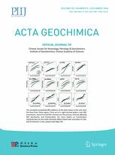
Acta Geochimica
Pioneering Research in the Chemical Composition of Our World.Acta Geochimica is a prominent academic journal published by SPRINGER INT PUBL AG, focusing on the dynamic fields of Geochemistry and Petrology. Established in 2016, this peer-reviewed publication has quickly gained recognition within the scientific community, currently holding a category quartile ranking of Q3 in Geochemistry and Petrology as of 2023. With its ISSN 2096-0956 and E-ISSN 2365-7499, the journal offers a platform for researchers and professionals to disseminate and discuss significant advancements in the study of the chemical composition of the Earth and other celestial bodies. While it is not an open-access journal, Acta Geochimica plays a vital role in fostering collaboration and innovation among scientists, contributing to a deeper understanding of geochemical processes. Located in Switzerland at Gewerbestrasse 11, Cham CH-6330, Switzerland, this journal is a critical resource for students, researchers, and professionals seeking to push the boundaries of knowledge in Earth sciences.
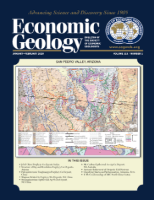
ECONOMIC GEOLOGY
Uncovering Earth's Treasures Through Rigorous ResearchECONOMIC GEOLOGY, published by the Society of Economic Geologists, Inc., is a premier journal dedicated to the field of economic geology, geochemistry, petrology, geology, and geophysics. With a significant legacy dating back to 1905 and converging into 2024, this journal has established itself as a leading source of research and knowledge in the geosciences, recognized for its high-quality, peer-reviewed articles that reflect the latest advancements in the discipline. Having achieved an impressive impact factor and categorized in the top Q1 quartiles, it ranks among the foremost journals in various related fields, including Earth and Planetary Sciences—where it particularly excels in geophysics (Rank #5) and geochemistry (Rank #6). Although it currently does not offer open access options, its rigorous publication standards ensure that the research disseminated significantly contributes to the understanding and exploration of geological resources. This journal is essential reading for researchers, professionals, and students who seek to deepen their knowledge and stay at the forefront of economic geology.
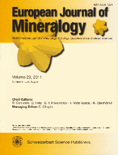
EUROPEAN JOURNAL OF MINERALOGY
Empowering scholars with cutting-edge findings in mineralogy.The EUROPEAN JOURNAL OF MINERALOGY, published by COPERNICUS GESELLSCHAFT MBH, is a pivotal open-access journal dedicated to advancing the fields of Geochemistry and Petrology. With a rich history spanning from 1989 to 2024, this journal has established itself as a key resource for researchers and professionals alike, achieving a commendable Q2 category ranking in its field for 2023. Its inclusion in the Scopus database ranks it 79 out of 154 in Earth and Planetary Sciences, reflecting its impact within the scientific community. With an open access model since 2020, the journal facilitates broad dissemination of high-quality research findings, thereby enhancing accessibility and engagement among scholars and students globally. Set against the backdrop of Germany’s vibrant academic landscape, the EUROPEAN JOURNAL OF MINERALOGY continues to play a crucial role in fostering dialogue and innovation in mineralogical sciences.

PHYSICS AND CHEMISTRY OF MINERALS
Bridging Theory and Application in Mineral SciencesPHYSICS AND CHEMISTRY OF MINERALS, published by SPRINGER, is a premier journal dedicated to advancing the understanding of the physical and chemical properties of minerals, their interactions, and their significance in various geological processes. With an ISSN of 0342-1791 and an E-ISSN of 1432-2021, this journal serves as a vital resource for researchers and professionals in geochemistry and petrology, as well as materials science. Reflecting the journal's commitment to quality scholarship, it has achieved Q3 rankings in both Geochemistry and Petrology, and Materials Science (miscellaneous) categories. Established in 1977 and continuing through 2024, the journal has consistently provided a platform for high-impact research, fostering collaboration and innovation in the field. Located in Germany and reaching a global audience, PHYSICS AND CHEMISTRY OF MINERALS is instrumental for students, academics, and industry experts looking to stay at the forefront of mineral research and applications.

CONTRIBUTIONS TO MINERALOGY AND PETROLOGY
Cultivating Knowledge in Geophysics and PetrologyCONTRIBUTIONS TO MINERALOGY AND PETROLOGY, published by SPRINGER, is a premier journal in the fields of geochemistry, petrology, and geophysics, boasting an impressive impact factor that reflects its status as a leader in the discipline. With a history spanning from 1966 to 2024, this journal has consistently provided a platform for high-quality research that influences our understanding of earth materials and processes. Ranked in the top quartile (Q1) in both geochemistry and petrology, as well as geophysics, it stands out with Scopus rankings of #24 out of 165 in Geophysics and #37 out of 154 in Geochemistry and Petrology, indicating its critical role in advancing scientific knowledge. As a vital resource for researchers, professionals, and students alike, the journal invites contributions that foster collaboration and innovation in the study of minerals and rocks. Although it does not currently offer open access, its scholarly rigor and relevance to contemporary issues ensure it remains an indispensable part of the academic discourse within this field.
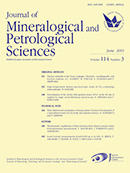
Journal of Mineralogical and Petrological Sciences
Innovative Insights into Earth’s CompositionThe Journal of Mineralogical and Petrological Sciences, published by the Japan Association of Mineralogical Sciences, serves as a vital platform for disseminating high-quality research in the fields of mineralogy and petrology. With a presence in both traditional and digital formats (ISSN: 1345-6296; E-ISSN: 1349-3825), this journal fosters scholarly engagement and innovation within these crucial branches of Earth Sciences. As evidenced by its Q3 ranking in both Geology and Geophysics categories for 2023, Journal of Mineralogical and Petrological Sciences maintains a significant standing within the academic community, contributing to the ongoing discourse and exploration of mineralogical phenomena and processes. Researchers, professionals, and students alike will find valuable insights and advancements represented within its pages, with a commitment to inclusivity in research output spanning two decades (2000-2024). Although not currently open access, the journal remains a key resource for understanding the complexities of our geological world.
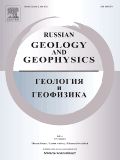
Russian Geology and Geophysics
Connecting Knowledge and Innovation in Earth SciencesRussian Geology and Geophysics is a seminal journal published by GEOSCIENCEWORLD that plays a pivotal role in the dissemination of vital research within the realms of Earth-Surface Processes, Geology, and Geophysics. With an ISSN of 1068-7971 and an E-ISSN of 1878-030X, this journal has witnessed a continuous evolution since its convergence in 2007 and is poised to thrive through 2024. While it is not an Open Access journal, it is recognized for its significant contributions to the academic community, holding a respectable Q2 ranking in Earth-Surface Processes and Q3 rankings in both Geology and Geophysics as of 2023. The journal’s impact factors align it within competitive quartiles, marking it as an essential resource for researchers and professionals seeking to stay at the forefront of geological and geophysical sciences. By publishing high-quality peer-reviewed articles, the journal fosters an environment of knowledge sharing and innovation, making it indispensable for students, practitioners, and scholars alike who are dedicated to advancing our understanding of Earth's complex systems.
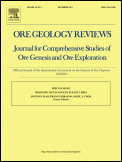
ORE GEOLOGY REVIEWS
Elevating Knowledge in Ore Geology and BeyondORE GEOLOGY REVIEWS is a premier academic journal published by Elsevier, renowned for its influential contributions to the fields of Economic Geology, Geochemistry, and Petrology, and Geology. With its esteemed Q1 ranking across these disciplines in 2023, it occupies a leading position in shaping scholarly discussions and advancements within the geological sciences. With an impressive Scopus ranking—47th in Earth and Planetary Sciences for Geology, and among the top 40 in Geochemistry and Petrology—this journal serves as an essential resource for researchers, professionals, and students committed to advancing knowledge in ore geology. Having transitioned to an Open Access model in 2022, ORE GEOLOGY REVIEWS enhances the accessibility of high-quality research, promoting wider dissemination and engagement with cutting-edge findings from 1986 to 2024. As a valued publication addressing the intricacies of ore deposits and geochemical processes, it aims to foster interdisciplinary collaboration and innovation in the field.

Periodico di Mineralogia
Fostering Excellence in Earth Science ResearchPeriodico di Mineralogia, published by SAPIENZA UNIV EDITRICE, is a distinguished academic journal based in Italy that has been pivotal in advancing the fields of Geochemistry, Geology, and Geophysics since its inception in 1979. With an ISSN of 0369-8963 and an E-ISSN of 2239-1002, the journal boasts a solid reputation reflected in its Q3 category rankings across these disciplines as per 2023 metrics. The journal’s scope encompasses a broad range of topics related to mineralogy and earth sciences, providing a vital platform for researchers, professionals, and students to disseminate their findings. Despite the absence of an Open Access option, Periodico di Mineralogia remains an essential resource for the dissemination of high-quality research that contributes to our understanding of earth processes and materials. Situated in the heart of Rome at PIAZZALE ALDO MORO 5, it serves as a crucial bridge between academic research and practical applications in geology and planetary sciences.
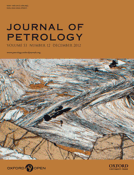
JOURNAL OF PETROLOGY
Illuminating the Foundations of Geophysics and MineralogyJOURNAL OF PETROLOGY is a prestigious academic journal published by Oxford University Press, dedicated to the fields of geochemistry, petrology, and geophysics. Established in 1960, it has garnered significant recognition within the scientific community, currently holding an impressive Q1 ranking in both Geochemistry and Petrology as well as Geophysics, as of 2023. The journal is indexed in Scopus, ranking 20th out of 165 in Geophysics and 31st out of 154 in Geochemistry and Petrology, reflecting its high impact and contribution to Earth and Planetary Sciences. Designed for researchers, professionals, and students, the journal publishes cutting-edge research and reviews that advance our understanding of igneous and metamorphic processes, mineralogy, and the Earth's structure. With a commitment to rigor and scientific excellence, JOURNAL OF PETROLOGY serves as a vital resource for developing new concepts and methodologies in the study of Earth’s materials and processes.